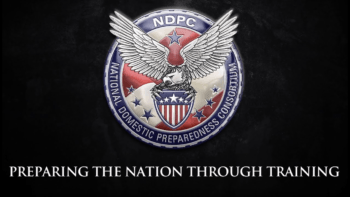Texas A&M And LSU Work Together To Make The Nation Safer
 When Texas A&M University and Louisiana State University (LSU) face each other on the gridiron, the focus is on competition. But throughout the year, the focus is on partnership, through the Texas A&M Engineering Extension Service’s National Emergency Response and Rescue Training Center (TEEX/NERRTC) and LSU’s National Center for Biomedical Research and Training (NCBRT).
When Texas A&M University and Louisiana State University (LSU) face each other on the gridiron, the focus is on competition. But throughout the year, the focus is on partnership, through the Texas A&M Engineering Extension Service’s National Emergency Response and Rescue Training Center (TEEX/NERRTC) and LSU’s National Center for Biomedical Research and Training (NCBRT).
Both TEEX/NERRTC and LSU’s NCBRT are members of the elite National Domestic Preparedness Consortium (NDPC), a professional alliance sponsored through the Department of Homeland Security/Federal Emergency Management Agency (DHS/FEMA).
The consortium, established in 1998, is comprised of seven members: four universities, two federal entities, and one private organization – charged with the mission to prevent, protect against, mitigate against, respond to, and recover from terrorism, natural disasters, catastrophic accidents, and other hazards occurring in the states, territories and local and tribal jurisdictions.
“We have had a partnership with LSU’s NCBRT for many years and we have strong working and personal relationships with the members of their center,” stated Al Davis, director of TEEX/NERRTC. “Personal relationships are the foundation of success in any endeavor, and have never been more important than in our recent joint initiative to help the states assess their own preparedness and identify their training needs.”
Tom Tucker, director for LSU’s NCBRT, added, “We have a long history of working with TEEX/NERRTC on various projects which have a direct impact on the security of our nation. Our current collaboration focuses on the development and delivery of the ‘Readiness: Training Identification and Preparedness Planning’ course.”
The purpose of this collaboration is to empower states and local jurisdictions to create effective training plans using the whole community approach. Basically, the participants have to ask themselves how prepared they need to be and in what specific areas to execute their emergency operations plans and candidly assess how prepared they really are. The gap between the two is what this initiative addresses.
As Davis put it: “Together we are helping them to help themselves.”
As one of the founding members of the NDCP, this is just one of the many courses, workshops, programs and collaborations in which TEEX/NERRTC is involved.
Training efforts are supported by four TEEX operational training divisions: Emergency Services Training Institute (ESTI), Infrastructure Training and Safety Institute (ITSI), Public Safety and Security (PS&S), and Knowledge Engineering (KE).
Each division possesses a unique set of competencies that enable TEEX/NERRTC to sustain its relevance within the homeland security and national preparedness community. Together, these divisions support the TEEX/NERRTC mission to provide the expertise in training for a broad spectrum of hazards across the country and to assist in local, state, and designated federal emergency training.
Said Davis, “A critical component to our training efforts are the subject matter expert instructors and support staff, who on a daily basis give 110 percent effort. These unsung heroes develop, deliver and support over 900 course deliveries annually, nationwide.
For example, NERRTC was in Boston to conduct training sessions on “Medical Preparedness and Response for Bombing Incidents” four times during the six-month period prior to the Boston Marathon bombing; the sessions were attended by city, county, state and Massachusetts General Hospital responders. In fact, the EMS member stationed at the finish line of the marathon had attended one of the training sessions. He testified before the Senate and stated in the news that he knew exactly what to do because the training they had received helped them with everything from how to clear the scene to minimizing the loss of life.
NERRTC had also trained the New York and New Jersey Port Authority on everything from infrastructure to communications two months before “Sully” Sullenberger’s amazing landing in the Hudson River, known as the “Miracle on the Hudson.” Emergency responders handled the situation expeditiously and were praised for their efforts.
Brian Onieal, New Jersey Office of Homeland Security, sent Davis the following email:
“Please thank the staff of TEEX for their help in preparing our first responders and private sector for this port emergency. Everyone is complimenting the unified command operational effectiveness. Good outcomes during emergencies always start with good training.”
On Sept. 16, 2013 NERRTC was awarded $21.1 million through DHS/FEMA’s Homeland Security National Training Program Cooperative Agreement. The award is for Federal Fiscal Year 2013, which is projected to cover training provided by NERRTC from Sept. 1, 2014, through Aug. 31, 2015. The money funds a Cooperative Agreement, which is the foundation of the relationship between the NDPC and DHS/FEMA in creating and sustaining a culture of preparedness.
Since its inception, the NDPC has trained over 2 million training course participants representing all emergency response disciplines.
*NDPC members: Texas A&M Engineering Extension Service National Emergency Response and Rescue Training Center (TEEX), Louisiana State University’s Academy of Counter-Terrorist Education (National Center for Biomedical Research and Training), the New Mexico Institute of Mining and Technology (New Mexico Tech), the National Disaster Preparedness Training Center at the University of Hawaii (NDPTC), the Center for Domestic Preparedness (CDP) in Anniston, Ala., the Department of Energy’s Nevada Test Site (NTS) and the Transportation Technology Center, Inc. (TTCI).





